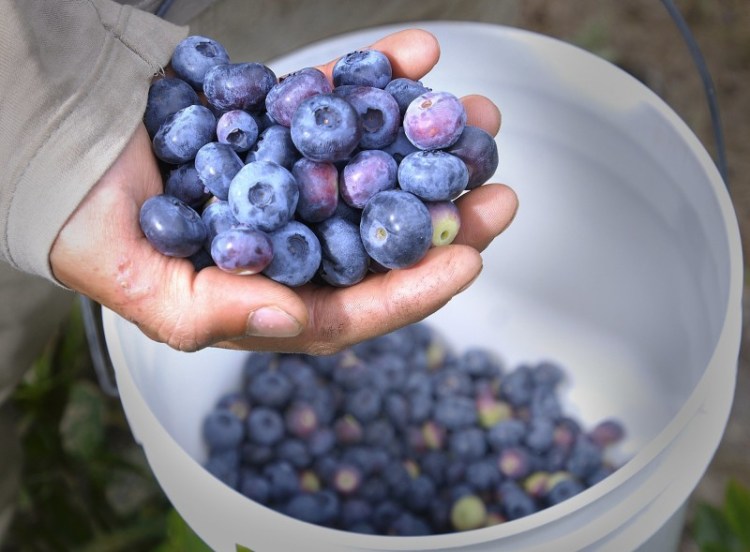Maine wild blueberries are called low-bush berries because the plants grow only 6 to 18 inches high, as opposed to the much taller high-bush cultivated blueberries. Maine blueberries, which are smaller and usually a little less sweet than cultivated berries, nevertheless possess a distinctive, intense, almost winey flavor that is incomparable.
One of North America’s few native fruits (cranberries and wild grapes are two others), low-bush blueberries grow thickly on the treeless sandy barrens in coastal Maine, particularly way Down East in Washington County.
These days, the berries are technically called an “assisted wild crop,” because while growers do not cultivate the plants per se, they do irrigate, fertilize, spray, mow and pollinate the crop.
While some growers are using mechanical harvesters, most blueberry gathering is still done by hand with a steel rake that is pulled through the tangled branches, its teeth close enough together to catch the small fruit. It takes a skillful teasing movement to remove berries from their stems without breaking their skins.
After harvesting, the crop is sold fresh for a few brief August weeks and canned or flash-frozen for domestic and overseas markets.
BEAUTIFUL BLUEBERRY CORNBREAD
Serves about 6
With its golden cornmeal hue and studs of purply blueberries that spurt sweet-tartly on the tongue, this bread seems to capture Maine summer in a pan. It’s lovely for weekend house guest breakfasts or for snacking out of hand at any time.
If you use frozen blueberries, knock off any ice crystals but do not thaw before adding the berries to the batter.
An 8½- by 4½-inch pan will result in a more domed loaf and takes the longer baking time; a 9- by 5-inch pan yields a slightly flatter bread and will take the shorter baking time.
1½ cups all-purpose flour, plus 2 tablespoons
¾ cup yellow cornmeal
2 teaspoons baking powder
1 teaspoon salt
6 tablespoons unsalted butter, softened
¾ cup granulated sugar
2 eggs
¾ cup milk, whole or low-fat
¾ cup fresh or frozen blueberries
Preheat the oven to 350 degrees. Grease a loaf pan and line the bottom with a piece of parchment for extra unmolding insurance.
In a medium bowl, whisk together the 1½ cups flour, cornmeal, baking powder and salt.
In a large bowl, using an electric mixer, beat the butter and sugar until smooth. Beat in the eggs, scraping the sides of the bowl as necessary, until well blended. With mixer on low speed, add half the flour mixture, then the milk, then the rest of the flour mixture, and beat just until blended.
Toss the blueberries with the remaining 2 tablespoons flour and fold them into the batter. Scrape into the prepared baking pan, smoothing the top. Bake in the center of the preheated oven for 45 to 50 minutes until deep golden brown on top and a skewer inserted in the center of the loaf comes out clean.
Cool in the pan for 5 minutes, then run a knife around the cake and unmold onto a wire rack.
Serve warm or room temperature or wrap well, and refrigerate for up to 2 days or freeze.
SMALL-BATCH BLUEBERRY PRESERVES
Makes 3 half-pint jars
I love to capture the essence of summer fruits by making jam, but am not all that keen on standing over a steaming kettle in August or dealing with the sometimes-daunting admonitions of water bath processing. I prefer to put up a few jars of our prized native blueberries at a time and store them in the refrigerator, from which they disappear long before they’ve had a chance to spoil.
2 cups Maine blueberries
11/3 cups sugar
1 tablespoon lemon juice
¼ teaspoon butter
Half a cinnamon stick
2½ tablespoons liquid pectin
Combine berries, sugar, lemon juice, butter and cinnamon stick in a wide heavy saucepan or medium-sized deep skillet. Use a potato masher to crush the berries to release their juice.
Bring to a full rolling boil over high heat, stirring almost constantly. Boil for 1 minute. Add pectin, return to a boil, and boil for 1 minute, stirring. Remove from the heat.
Discard cinnamon stick and ladle the preserves into clean glass canning jars or other jars.
Cool to room temperature (preserves will thicken as they cool), cover and refrigerate for up to 3 weeks.
Brooke Dojny is author or co-author of more than a dozen cookbooks, most recently “Lobster!” (Storey, 2012). She lives on the Blue Hill peninsula, and can be contacted via Facebook at:
facebook.com/brookedojny
Send questions/comments to the editors.



Comments are no longer available on this story